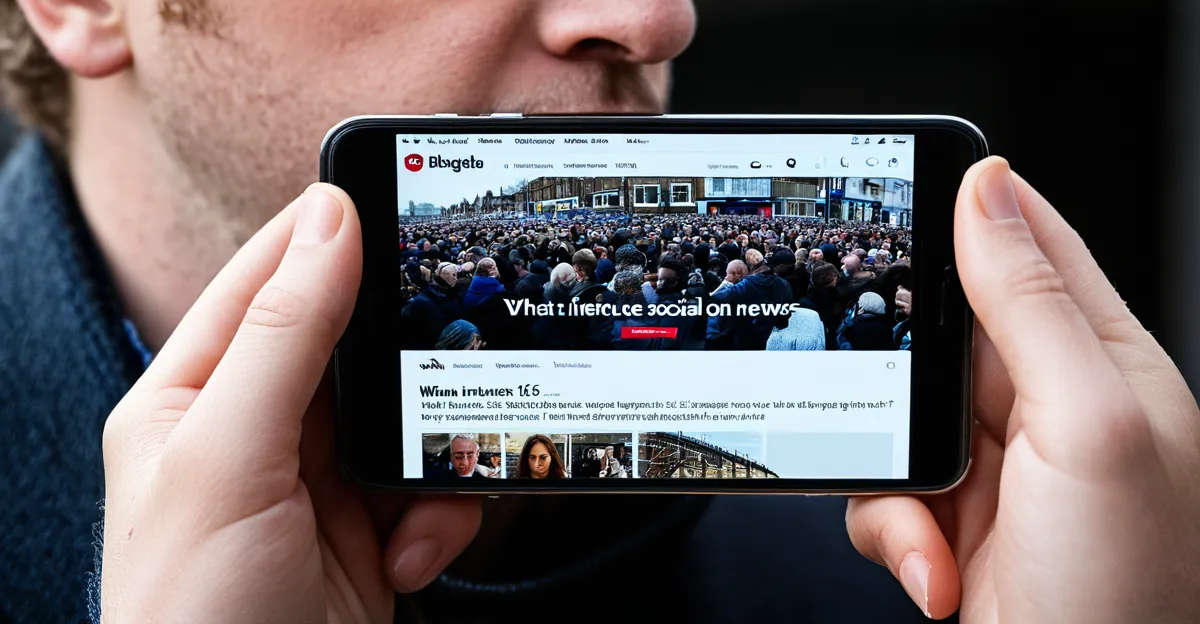Social Media’s Influence on UK News Dissemination
Social media influence has become a driving force in UK news dissemination, transforming the way people receive and interact with information. Platforms like Twitter/X, Facebook, and Instagram are no longer just for social connections—they have evolved into vital news sharing platforms. In fact, many UK residents now turn to these outlets as their primary source for breaking news and updates.
Recent statistics underscore this shift. Over 60% of adults in the UK cite social media as a key channel for news consumption, surpassing traditional news sources such as TV and newspapers. This trend highlights the growing dominance of social media influence in shaping public opinion and access to information.
In the same genre : What Are the Future Implications for UK Politics in Light of Recent Developments?
Twitter/X, in particular, serves as a hub for real-time news broadcasting; journalists, influencers, and news outlets actively engage users through quick updates and interactive content. Meanwhile, Facebook and Instagram offer more visual and personalized news experiences, enabling users to share and discuss news stories within their circles.
As social media influence continues to expand, the landscape of UK news dissemination adapts to meet the demands of an increasingly connected and digitally savvy audience. This evolution encourages both news providers and consumers to embrace versatility and speed in news sharing platforms.
This might interest you : What are the latest trends in UK digital journalism?
Changing Patterns in News Consumption
Understanding the evolving landscape of how people engage with news
The landscape of news consumption habits has undergone a profound shift, with digital platforms now dominating the way audiences access information. Traditional print newspapers and broadcast outlets are steadily losing ground as UK online news consumption grows rapidly, fueled by the convenience and immediacy of digital media.
Evidence shows that UK digital audiences increasingly rely on social media as a primary news source. Platforms like Twitter, Facebook, and Instagram have transformed from simple social spaces into major news hubs, attracting diverse demographic groups, but especially younger viewers. This shift highlights behavioural trends where real-time updates and personalized news feeds are preferred over scheduled broadcasts or printed editions.
Focusing on younger demographics, a notable case study reveals that these audiences demonstrate a strong preference for relying on social channels for news discovery. This group values the interactivity and community aspect of social media, often engaging with news through comments, shares, and live discussions. Their patterns contrast sharply with older generations who may depend more on traditional news sources or official websites.
The trend to digital, especially social media, reflects changing expectations for immediacy and customization in news delivery, forcing news providers to adapt to maintain relevance among the UK’s evolving digital audience.
Effects on Public Opinion and Perception
Understanding the digital influence landscape
Social media algorithms play a pivotal role in shaping public opinion by carefully curating the content each user sees. These algorithms prioritize engagement, often creating filter bubbles—echo chambers where people mainly encounter views similar to their own. This selective exposure limits diverse perspectives and can deepen societal divisions.
When a story goes viral or trends on platforms, it rapidly becomes a focal point in the national conversation. Such trending topics can elevate issues that might otherwise receive limited attention, thereby directing collective awareness and sometimes prompting swift public reactions or policy debates.
Experts emphasize the incredible power social media holds in influencing and polarizing public attitudes. In particular, algorithm-driven visibility means that certain narratives gain momentum more easily, which can reinforce biases. This complex interaction between algorithmic choices and user behavior makes it essential for both platforms and users to be mindful of how public opinion is formed and manipulated.
Understanding how social media algorithms and filter bubbles function enables us to critically assess the information we consume, promoting a more balanced and informed public discourse.
Social Media’s Role in Journalistic Practices
Exploring how social platforms reshape news reporting and sourcing
The rise of social media sourcing has transformed traditional journalism trends, making platforms like Twitter and Facebook integral to modern news reporting. Newsrooms increasingly integrate social media tools to gather real-time information, monitor public sentiment, and even uncover breaking stories. This shift allows journalists to tap directly into eyewitness accounts and citizen-generated content, providing a rich, immediate source of information often unavailable through conventional channels.
However, the reliance on social media presents challenges too. While citizen contributions can accelerate reporting, they raise concerns about accuracy and verification. Journalists must navigate misinformation carefully, employing fact-checking techniques to distinguish credible reports from rumors. For instance, during breaking news, social media posts are frequently cross-verified with multiple sources before publication, reducing the risk of amplifying false information.
The evolution of journalism trends reflects a balance—leveraging the agility of social media sourcing while maintaining rigorous editorial standards. This approach not only broadens news coverage but also encourages public engagement in news creation, ultimately enriching the entire reporting process.
Misinformation, Disinformation, and Fake News
Understanding the challenges in today’s digital UK landscape
In the UK, misinformation and fake news are widespread on major social channels, often spreading faster than verified information. Platforms like Twitter, Facebook, and Instagram serve as hotspots where misleading content flourishes, impacting public opinion on critical issues. For example, during UK elections and health crises, there have been notable cases where false claims gained momentum, influencing voters and public health responses.
Addressing fake news requires robust interventions. The UK has invested heavily in fact checking and verification initiatives. Organisations dedicated to UK fact checking systematically analyse suspect content, exposing inaccuracies and providing verified information. These efforts are vital in halting the viral spread of misinformation.
Policies at both government and platform levels have become stricter, promoting transparency and accountability. Collaborations between social platforms and independent fact-checkers enhance the reliability of content users see. Automated tools also assist in detecting fake news patterns rapidly.
Understanding the mechanics behind misinformation and leveraging UK fact checking methods encourage critical consumption of digital content. By staying informed about these tools and trends, readers can better differentiate trustworthy news from misleading narratives, fostering a more accurate and informed online community.
Positive and Negative Impacts on UK News Ecosystem
Balancing media trust and democratic engagement
Social media plays a crucial role in fostering democratic engagement by amplifying diverse voices and encouraging public participation. Platforms allow users to access a broad range of viewpoints, breaking traditional media monopolies and enabling grassroots movements. This diversity contributes positively to media trust when users feel represented and informed.
However, this ecosystem also faces significant challenges. The rise of echo chambers can limit exposure to opposing perspectives, reinforcing biases. Additionally, online harms such as abuse and misinformation have contributed to a notable decline in media trust. Many UK news consumers express concerns that unchecked digital spaces erode the quality and credibility of journalism.
Balancing these impacts requires careful consideration. While social media supports democratic participation by broadening access to information, it simultaneously demands greater responsibility to mitigate risks. Investing in media literacy, ethical platform governance, and transparent reporting practices can help sustain trust. These strategies benefit UK journalism and society by safeguarding open discourse while addressing the negative consequences of digital communication. Such an approach ensures media trust grows alongside democratic engagement, rather than dwindling due to online harms.









